
views
Developing and Sharing Your Views

Find your voice. As a newspaper columnist, you’re charged to have distinct opinions and a voice. Your voice could be humorous or dark, for example. A good way to find your voice is to read newspaper articles that report just the facts, and then freewriting a response. Do this with 5 or 6 articles, then chart how you reacted. You might notice that you consistently take a sarcastic tone or an optimistic one. Your editor will also be able to help you refine your voice, so don’t be afraid to reach out.
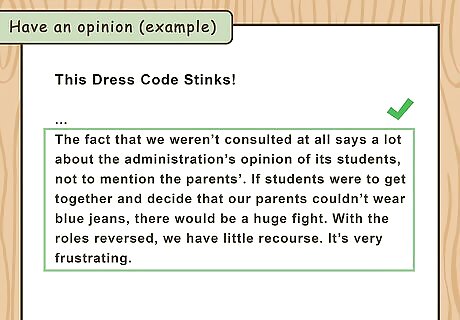
Have an opinion. What distinguishes a newspaper column from an article is that a column inserts an opinion where the article only reports facts in an objective way. Forming an opinion is a good way to speak your voice. A good way to test your opinion is to ask yourself, “Will someone have a strong reaction to my article?” If the answer is yes, you’ve successfully formed an opinion. If your stance doesn’t elicit any reaction, then you’ve probably written a very neutral piece. Make sure you can back that opinion up with researched evidence. This will help persuade your readers to buy into your opinion.
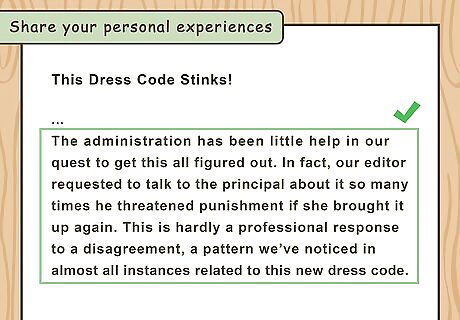
Share your personal experiences. A good way to develop a voice and opinion is to draw from your own personal experiences. Including anecdotes from your own life will not only make you more relatable to your reader, but also more credible. If you’ve had a situation where prescription drug costs buried you financially, start off your column with an anecdote about this time in your life before you lay out your fiery opinion on the high cost of prescription drugs for seniors.
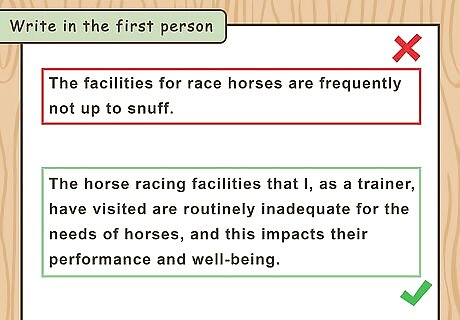
Write in the first person. Since a column is based on your opinion, incorporate your voice by using “I.” This will remind the reader of your presence and will help establish which opinions presented are yours. Instead of saying, “The facilities for race horses are inadequate,” use first person to make the statement more compelling. For example: “The facilities that I, as a trainer, have visited don't meet the horses needs, which affects their performance and well-being.”
Choosing Your Column Topic

Look to current events. Your readers will be most interested in topics that are dominating the news, such as politics or pop culture, and not some obscure event that’s no longer relevant. Stay on top of the news cycle and be ready to jump in with your own opinion. Scan newspaper and magazine headlines to see what events are most popular. These reoccurring issues are ones that the general public will be interested in. Often newspaper columns are about politics, but they can draw on social issues also, such as prison conditions.

Find an interesting angle for your topic. Providing your readers with a fresh approach to a story can make your column appealing. Thinking about new angles for a topic on current events will be sure to speak to readers. Don’t be afraid to include yourself in your topic. Look at your own personal history for a way to contribute something unique to your column. Dive into the details and see where they take you. Looking closely at details may provoke a new idea. Focusing on local angles is a great way to make your column relevant to your reader.
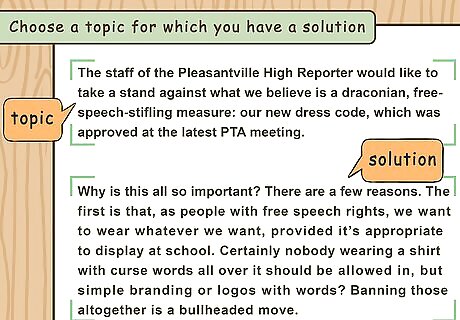
Choose a topic for which you have a solution. Have the conviction to suggest a solution or two for the opinion you’ve stated. Readers are looking for answers when they pick up a newspaper column, and it’s your job as the columnist to provide them. If, for example, you’re going to say, “Social media use by students during school hours is crushing student productivity,” you’d better be prepared to offer a solution to get students to put aside social media and concentrate on the tasks at hand. If you’ve got a strong point of view on a particular topic, but have no solutions to offer, you should wait to write the column until you’ve got more concrete solutions.
Engaging Your Audience

Have a catchy title. They often include numbers, fun adjectives, and a promise to the reader. This will help set the reader's expectations and grab his or her attention. For example, “Getting Stains Out of Your Carpet” is a mundane title that’s not likely to capture your reader’s attention. Alternatively, “3 Unusual Household Items That’ll Get Red Wine Stains Out” is more interesting because it gives the reader a promise.
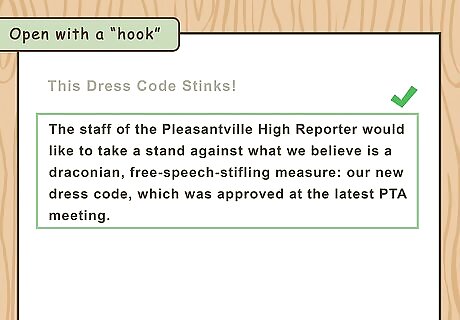
Open with a “hook” that will grab your reader’s attention. Make that first sentence count by enticing the reader with your words and ideas. Remember that your opening also lays the foundation for your argument, so make sure it’s relevant. Attention-grabbing opening lines include: dramatic anecdotes, controversial statements, irony and wit, references to new studies, or statements that contradict conventional wisdom.
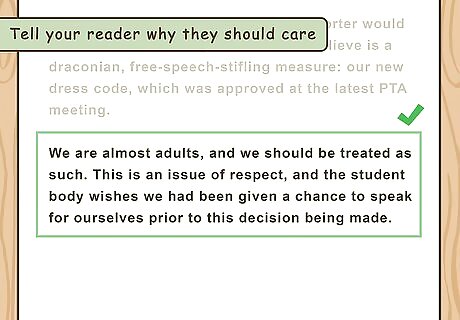
Tell your reader why they should care. As you write your article make sure every paragraph can answer the question: “Who cares?” Explain why your topic is relevant to your readers and how it will positively or negatively affect them. For example, if you’re writing against a new tax proposal, explain to your readers that this new policy will increase their taxes.
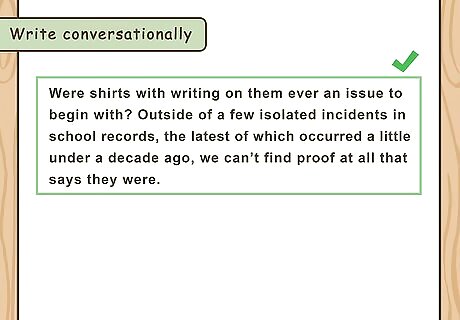
Write conversationally. While you shouldn’t throw all the writing rules out the window, you should avoid jargon, technical language, and complex sentence structure. By writing in a more conversational manner, you’ll be able to communicate your point to your audience more effectively. Try writing in shorter sentences or using contractions to adopt a more conversational style. Pretend that you’re writing to a friend and address the reader directly. Try talking in your head as you write and then read it aloud afterwards to see how it sounds.
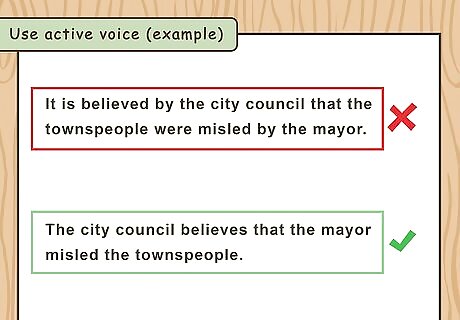
Use active voice. Using active verbs comes across as more authoritative and it’ll help cut down on wordiness. Since you’re trying to convince a reader of your opinion, using strong, active verbs will help you do this. Stating that, “It is believed by the city council that the townspeople were misled by the mayor” is wordy and leaves the author wondering if the city council is an authoritative source. Instead, try writing that, “The city council believes that the mayor misled the townspeople.” You can note how the active voice sentence is more authoritative and straightforward.
Formatting Your Column
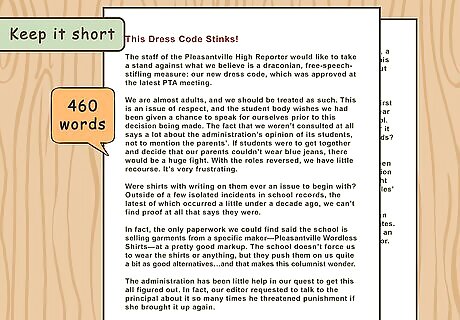
Keep your column short. Newspaper columns are typically only 400-800 words so you should get to your point straightaway. Get used to whittling down your initial drafts. After you read each sentence ask yourself, “How is this sentence contributing to my argument? Is every word necessary?” If you find yourself unsure whether words or sentences contribute to your argument, take them out and read the article again to see if their absence alters your argument.

Make sure your topic is clearly defined. Because newspaper columns are short, your topic and point of view must be clearly defined and focused. State your topic and opinion in the first paragraph. The following paragraphs should relate back to this idea. For example, if you’re writing that long-distance relationships are a bad idea, introduce this idea in the first paragraph. Present the problematic aspects of long-distance relationships in the following paragraphs to support your stance.

Do your research. While column writing does leave a lot of room for your own personal voice, it should be anchored in facts. Backing up your opinion with facts will help make your case for your readers. You can conduct research at the library or from your computer, but you can also conduct field research by interviewing people involved in your story. Always make sure you properly cite your sources. If you include a quote be sure to name your source and their expertise. This way the reader is able to assess the reliability of that person's statement.

Use Associated Press format. Journalism has its own specific writing style that ensures that all newspaper writers have consistent guidelines to follow. Journalism's punctuation is very different from your normal English formatting so you’ll need to review the AP format carefully.

















Comments
0 comment